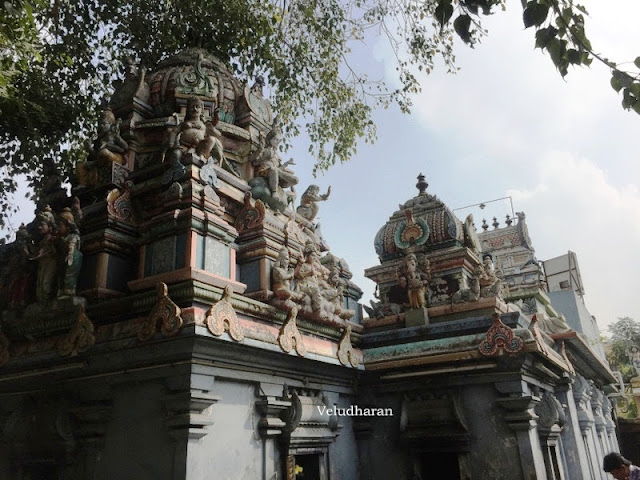15th January 2019.
When I was searching an old Shiva Temple in Tharamani area on 15th January 2019, I came across this Temple built like a 3 storied flat with small gopuras on the top with saffron flags. For almost 5 and odd years I used to travel on this Yerikarai street to reach my office, not went inside the this temple. To day I had the opportunity of visiting this temple.
The presiding deity : Sri Panchamukha Anjaneyar.
The Anjaneyar is in kneeling position with his right knee touching the ground. The Faces are Hanuman, Narasimha, Garuda, Varaha and Hayagriva. Anjaneyar has 10 hands holding weapons Kumbh, Soolam, axe, chakra, Sword, Shield, Thanda, and a pot. Lower right hand in abhaya hastha and left hand holds a curved knife.
The temple is being maintained by the Bhakti Vedanta Trust, having it’s headquarters at Bhadrak, Orissa, but conducts programs throughout India. This Bhaktivedanta Ashram was founded by His Divine Grace AC Bhaktivedanta Swami Prabhupada for the purpose of propagating sanadana dharma as taught by Lord Krishna. The main activities of the ashram includes distribution of food to the poor and educating people in general public in the understanding of Spiritual life. The Ashram believes that if physical hunger is removed, then it will be possible for the mankind to focus internally towards spiritual advancements.
His Divine Grace A C Bhaktivedanta Swami Prabhubada was born in 1896 in Calcutta and got initiated by his Guru Srila Bhaktisiddanta Sarasvati Goswami in 1922. From 1950 Swamiji retired from his married life and stayed at Vrindavan. He took Sanyasa in 1959 and began his work on Bhagavatham and written spiritual books based on Bhagavatam. He travelled may countries. Swamiji was the instrumental in establishing the International Society for Krishna Consciousness, more than one hundred ashrams, schools, temples, institutes and farm communities. Swamiji attained siddhi in 1977.
The temple is being manaaged by a Canada national by name Parkar who changed his name as Nithaidass. The Anjaneyar Sannadhi is in ground floor where as the madapalli / kitchen is in the first floor and the persons who does the pooja are in second floor.
TEMPLE TIMINGS:
The temple timings are 05.30 hrs to 12.00 hrs and 16.30 hrs to 20.00 hrs.
CONTACT DETAILS:
The Mobile number 8300181008 may be contacted for further details.
e-mail address : bvashram@gmail.com
HOW TO REACH:
About 500 meters from Tharamani Link Road on Yerikarai street
About 500 meters from Tharamani bus station ( Town bus route no 5C).
LOCATION:CLICK HERE
---OM SHIVAYA NAMA---











































